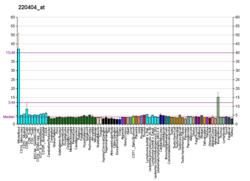GPR97
G-protein coupled receptor 97 also known as adhesion G protein-coupled receptor G3 (ADGRG3) is a protein that in humans is encoded by the ADGRG3 gene.[4][5][6][7] GPR97 is a member of the adhesion GPCR family.[8][9] Adhesion GPCRs are characterized by an extended extracellular region often possessing N-terminal protein modules that is linked to a TM7 region via a domain known as the GPCR-Autoproteolysis INducing (GAIN) domain.[10]
GPR97 is expressed in human granulocytes and endothelial cells of the vasculature as well as in mouse granulocytes, monocytes, macrophages, and dendritic cells.[7]
Signaling
[edit]The inositol phosphate (IP3) accumulation, aequorin, and 35S isotope binding assays in overexpressing HEK293 cells have demonstrated coupling of GPR97 to Gαo protein triggering cyclic adenosine monophosphate (cAMP).[11] GPR97 actives cAMP response element-binding protein (CREB), NF-κB, and small GTPases to regulate cellular functions.
Function
[edit]Systemic steroid exposure is a therapy to treat a variety of medical conditions and is associated with epigenetic processes such as DNA methylation that may reflect pharmacological responses and/or side effects. GPR97 was found to be differently methylated at CpG sites in the genome of blood cells from patient under systemic steroid treatment.[12] GPR97 is transcribed in immune cells. Gene-deficient mice revealed that Gpr97 is crucial for maintaining B-cell population via constitutive CREB and NF-κB activities.[13] Human lymphatic endothelial cells (LECs) abundantly express GPR97. Silencing GPR97 in human LECs indicated that GPR97 modulates cytoskeletal rearrangement, cell adhesion and migration through regulating the small GTPase RhoA and cdc42.[14] In vertebrates, GPR97 has an indispensable role in the bone morphogenetic proteins (BMP) signaling pathway in bone formation. A microarray meta-analysis revealed that mouse Gpr97 is a direct transcriptional target of BMP signaling in long bone development.[15]
References
[edit]- ^ a b c GRCm38: Ensembl release 89: ENSMUSG00000060470 – Ensembl, May 2017
- ^ "Human PubMed Reference:". National Center for Biotechnology Information, U.S. National Library of Medicine.
- ^ "Mouse PubMed Reference:". National Center for Biotechnology Information, U.S. National Library of Medicine.
- ^ Fredriksson R, Lagerström MC, Höglund PJ, Schiöth HB (Nov 2002). "Novel human G protein-coupled receptors with long N-terminals containing GPS domains and Ser/Thr-rich regions". FEBS Letters. 531 (3): 407–14. doi:10.1016/S0014-5793(02)03574-3. PMID 12435584. S2CID 7449692.
- ^ Kuźnicki J, Kuźnicki L, Drabikowski W (Jan 1979). "Ca2+-binding modulator protein in protozoa and myxomycete". Cell Biology International Reports. 3 (1): 17–23. doi:10.1016/0309-1651(79)90064-X. PMID 222487.
- ^ "Entrez Gene: GPR97 G protein-coupled receptor 97".
- ^ a b Hamann J, Aust G, Araç D, Engel FB, Formstone C, Fredriksson R, Hall RA, Harty BL, Kirchhoff C, Knapp B, Krishnan A, Liebscher I, Lin HH, Martinelli DC, Monk KR, Peeters MC, Piao X, Prömel S, Schöneberg T, Schwartz TW, Singer K, Stacey M, Ushkaryov YA, Vallon M, Wolfrum U, Wright MW, Xu L, Langenhan T, Schiöth HB (Apr 2015). "International Union of Basic and Clinical Pharmacology. XCIV. Adhesion G protein-coupled receptors". Pharmacological Reviews. 67 (2): 338–67. doi:10.1124/pr.114.009647. PMC 4394687. PMID 25713288.
- ^ Stacey M, Yona S (2011). Adhesion-GPCRs: Structure to Function (Advances in Experimental Medicine and Biology). Berlin: Springer. ISBN 978-1-4419-7912-4.
- ^ Langenhan T, Aust G, Hamann J (May 2013). "Sticky signaling--adhesion class G protein-coupled receptors take the stage". Science Signaling. 6 (276): re3. doi:10.1126/scisignal.2003825. PMID 23695165. S2CID 6958640.
- ^ Araç D, Boucard AA, Bolliger MF, Nguyen J, Soltis SM, Südhof TC, Brunger AT (Mar 2012). "A novel evolutionarily conserved domain of cell-adhesion GPCRs mediates autoproteolysis". The EMBO Journal. 31 (6): 1364–78. doi:10.1038/emboj.2012.26. PMC 3321182. PMID 22333914.
- ^ Gupte J, Swaminath G, Danao J, Tian H, Li Y, Wu X (Apr 2012). "Signaling property study of adhesion G-protein-coupled receptors". FEBS Letters. 586 (8): 1214–9. doi:10.1016/j.febslet.2012.03.014. PMID 22575658. S2CID 3020230.
- ^ Wan ES, Qiu W, Baccarelli A, Carey VJ, Bacherman H, Rennard SI, Agustí A, Anderson WH, Lomas DA, DeMeo DL (Dec 2012). "Systemic steroid exposure is associated with differential methylation in chronic obstructive pulmonary disease". American Journal of Respiratory and Critical Care Medicine. 186 (12): 1248–55. doi:10.1164/rccm.201207-1280OC. PMC 3622442. PMID 23065012.
- ^ Wang JJ, Zhang LL, Zhang HX, Shen CL, Lu SY, Kuang Y, Wan YH, Wang WG, Yan HM, Dang SY, Fei J, Jin XL, Wang ZG (10 October 2013). "Gpr97 is essential for the follicular versus marginal zone B-lymphocyte fate decision". Cell Death & Disease. 4 (10): e853. doi:10.1038/cddis.2013.346. PMC 3824656. PMID 24113187.
- ^ Valtcheva N, Primorac A, Jurisic G, Hollmén M, Detmar M (Dec 2013). "The orphan adhesion G protein-coupled receptor GPR97 regulates migration of lymphatic endothelial cells via the small GTPases RhoA and Cdc42". The Journal of Biological Chemistry. 288 (50): 35736–48. doi:10.1074/jbc.M113.512954. PMC 3861625. PMID 24178298.
- ^ Prashar P, Yadav PS, Samarjeet F, Bandyopadhyay A (May 2014). "Microarray meta-analysis identifies evolutionarily conserved BMP signaling targets in developing long bones". Developmental Biology. 389 (2): 192–207. doi:10.1016/j.ydbio.2014.02.015. PMID 24583261.



